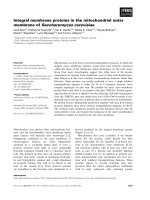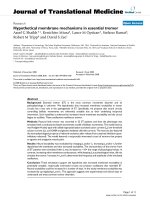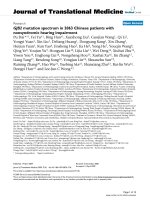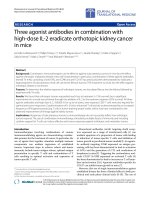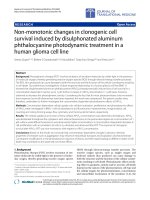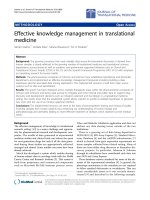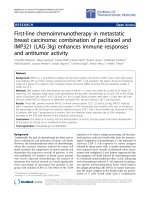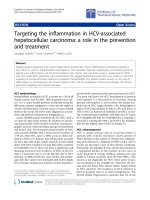báo cáo hóa học: "Walking speed-related changes in stride time variability: effects of decreased speed" docx
Bạn đang xem bản rút gọn của tài liệu. Xem và tải ngay bản đầy đủ của tài liệu tại đây (620.2 KB, 6 trang )
BioMed Central
Page 1 of 6
(page number not for citation purposes)
Journal of NeuroEngineering and
Rehabilitation
Open Access
Research
Walking speed-related changes in stride time variability: effects of
decreased speed
Olivier Beauchet*
†1
, Cedric Annweiler
1
, Yhann Lecordroch
2
, Gilles Allali
3
,
Veronique Dubost
4
, François R Herrmann
2
and Reto W Kressig
†5
Address:
1
Department of Internal Medicine and Geriatrics, Angers University Hospital, UPRES UNAM EA 2646, University of Angers, UNAM,
France,
2
Department of Rehabilitation & Geriatrics, Geneva University Hospitals, Switzerland,
3
Department of Neurology, Geneva University
Hospitals, Switzerland,
4
FORMADEP, Korian, France and
5
Department of Geriatrics, Basel University Hospital, Switzerland
Email: Olivier Beauchet* - ; Cedric Annweiler - ;
Yhann Lecordroch - ; Gilles Allali - ; Veronique Dubost - ;
François R Herrmann - ; Reto W Kressig -
* Corresponding author †Equal contributors
Abstract
Background: Conflicting results have been reported regarding the relationship between stride
time variability (STV) and walking speed. While some studies failed to establish any relationship,
others reported either a linear or a non-linear relationship. We therefore sought to determine the
extent to which decrease in self-selected walking speed influenced STV among healthy young adults.
Methods: The mean value, the standard deviation and the coefficient of variation of stride time,
as well as the mean value of stride velocity were recorded while steady-state walking using the
GAITRite
®
system in 29 healthy young adults who walked consecutively at 88%, 79%, 71%, 64%,
58%, 53%, 46% and 39% of their preferred walking speed.
Results: The decrease in stride velocity increased significantly mean values, SD and CoV of stride
time (p < 0.001), whereas the repetition of trials (p = 0.534, p = 0.177 and p = 0.691 respectively
for mean, SD, CoV); and step asymmetry (p = 0.971, p = 0.150 and p = 0.288 for mean, SD and
CoV) had no significant effect. Additionally, the subject's effect was significant for all stride
parameters (p < 0.001). The relationship between a decrease in walking speed and all stride
parameters (i.e., mean values, SD and CoV of stride time) was significantly quadratic and showed
higher STV at a slow speed (p < 0.001).
Conclusion: The results support the assumption that gait variability increases while walking speed
decreases and, thus, gait might be more unstable when healthy subjects walk slower compared with
their preferred walking speed. Furthermore, these results highlight that a decrease in walking speed
can be a potential confounder while evaluating STV.
Background
Human walking is an automated rhythmic motor behav-
ior [1-3]. Automaticity and rhythmicity imply that a
healthy subject is able to reproduce comparable limb-
coordinated movements from stride-to-stride while
steady state walking [2,3]. Stride-to-stride variability is a
measure of the consistency of limb movements [2]. In par-
ticular, stride time variability [STV], as calculated out off
Published: 5 August 2009
Journal of NeuroEngineering and Rehabilitation 2009, 6:32 doi:10.1186/1743-0003-6-32
Received: 26 August 2008
Accepted: 5 August 2009
This article is available from: />© 2009 Beauchet et al; licensee BioMed Central Ltd.
This is an Open Access article distributed under the terms of the Creative Commons Attribution License ( />),
which permits unrestricted use, distribution, and reproduction in any medium, provided the original work is properly cited.
Journal of NeuroEngineering and Rehabilitation 2009, 6:32 />Page 2 of 6
(page number not for citation purposes)
the mean and standard deviation [SD] of stride time and
expressed as the coefficient of variation [CoV], is a meas-
ure of temporal stride kinematic variability related to the
control of the rhythmic stepping mechanism. Low varia-
bility values of stride time reflect the automated regular
rhythmic feature of gait and are associated with safe gait
and are used as a clinical index of gait stability [4-9].
Because walking is one of the most repetitive and "hard
wired" human movements, STV is low and usually below
3% among young healthy adults [9-12].
Changes in gait variability outside of the normal range of
gait variability must be studied cautiously as several fac-
tors may influence STV. Although the relation between an
increased STV and certain neuro-degenerative diseases is
well-established [i.e., Parkinson's and Alzheimer's dis-
ease], the possible effect of a decrease in walking speed on
STV has been rarely examined and is still controversially
discussed [13-17]. Previous studies obtained conflicting
results, as some failed to find any relationship [12,13]
while others reported either a linear or a non-linear rela-
tionship [14-17]. Additionally, most of these studies did
not take into account the effects of potential confounders
that may modify the STV, such as between-subjects varia-
bility, the repetition of trials, left-right step asymmetry or
the use of motorized treadmills [6,7,12-17]. It is therefore
unclear whether an increase in STV is provoked either by
the decrease in walking speed, by confounders, or both.
The aim of this study was to determine the extent to which
a decrease in self-selected walking speed influenced STV
among healthy young adults.
Methods
Subjects
Twenty-nine young adults (15 men and 14 women; mean
age 28.3 ± 6.2 years; range: 18–39 years) were recruited
after having given their informed consent. The partici-
pants reported no physical or mental disorders. They were
not taking any medication. The study was approved by the
local Ethics Committee and conducted in accordance with
the ethical standards set forth in the Declaration of Hel-
sinki (1983).
Tasks and procedure
Participants were asked to straight walk in non-rand-
omized order and consecutively at 80%, 70%, 60%, 50%,
40%, 30%, 20% and 10% of their preferred walking
speed. Self-selected speed was freely chosen following the
instructions of evaluator to reduce the preferred walking
speed by 10% percentage. The subjects were instructed
that they should reduce their walking speed from their
preferred walking speed to 10% of it. The verbal instruc-
tions were standardized: "You will straight walking at
your self selected walking speed. You will start at your pre-
ferred walking speed and you will decrease your walking
speed stage by stage of 10% until walking to 10% of your
preferred walking speed. You will perform 3 trials for each
walking speed condition. Have you understood the
instructions? Do you have any question about this test?"
All subjects started gait recording with their preferred
walking speed. Because the design was based on freely
chosen walking speed, the real speed decreasing rate dif-
fered from the theoretical rate, and was therefore calcu-
lated using the following formula: [(measured self-
selected stride velocity/preferred stride velocity) × 100].
The results showed that participants actually walked at
89%, 80%, 72%, 65%, 58%, 53%, 46% and 39% of their
preferred walking speed. Participants completed 3 trials
for each level of decrease in walking speed. Before the test
was carried out, a trained evaluator gave standardized ver-
bal instructions regarding the test procedure with a visual
demonstration of the walking test. The walking trials were
carried out in a well-lit environment, with subjects wear-
ing their own footwear. According to the guidelines for
spatio-temporal gait analysis, and in order to ensure that
gait parameters were collected while steady state walking,
participants started walking at least 2 meters before reach-
ing the electronic walkway and completed their walk at
least two meters beyond it [18].
Apparatus
The GAITRite
®
-System (GAITRite Gold, CIR Systems, PA,
USA) is an electronic walkway-integrated, pressure-sensi-
tive electronic surface of 7.32 × 0.61 m, connected to a
portable computer via an interface cable [7]. The carpet
includes a series of sensors (a total of 13824 sensors)
placed every 1.27 cm with their centers placed in a 48 ×
288 grid and activated by mechanical pressure. The data
from the activated sensors is collected by a series of on-
board processors and transferred to the computer through
a serial port. The data is sampled from the carpet at a fre-
quency of 80 Hz, allowing a temporal resolution of 12.5
ms. Stride time (i.e. gait cycle duration) is defined as the
time elapsed between the first contact of two consecutive
footsteps of the same foot and is expressed in millisec-
onds.
Outcomes
The following outcome variables were used: Mean value
and SD expressed in second and CoV of stride time (CoV
= [(SD/mean) × 100] expressed in percentage; and Mean
value of stride velocity for each walking condition
expressed in cm.s
-1
. The primary outcome measure was
CoV of stride time. Mean value and SD of stride time, and
Mean value of stride velocity were the secondary out-
comes measures. Repetitions of trial, subjects' effect and
step asymmetry were used as covariates in data analysis.
Data analysis
Stride time and stride velocity values were summarized
using means and standard deviations. The normality of
Journal of NeuroEngineering and Rehabilitation 2009, 6:32 />Page 3 of 6
(page number not for citation purposes)
the parameters' distribution was verified with skewness
and kurtosis tests before and after applying usual transfor-
mations to try to normalize non-Gaussian variables. As
these transformations were unable to achieve normaliza-
tion of the distribution, raw values had to be used. Firstly,
a comparison of the outcomes, based on the Kruskal-Wal-
lis test, was carried out for the 3 trials of each walking con-
dition performed. The aim was to convert the three trials
into one single trial if no significant difference between
trials was observed. The Spearman Brown prophecy coef-
ficient was used to estimates test-retest reliability of the 3
trials. Secondly, a comparison of stride velocity for each
level of decrease in walking speed was performed using
the Cuzick test. Thirdly, a balanced repeated measures
analysis of variance (ANOVA) was performed in order to
estimate the effects of a decrease in walking speed on the
mean value, SD and CV of stride time while adjusting for
the 3 trial repetitions, for each walking condition and for
subjects' effect, taking account of the variability between
subjects and step asymmetry without interactions terms.
Fourthly, a univariate quadratic regression was performed
to separately explore the association between decreased
walking speed and mean value, SD, and CoV of stride
time, respectively; the preferred walking speed served as
reference level. P < 0.05 was considered statistically signif-
icant. Our statistics were calculated using the Stata Statis-
tical Software, release 9.2 [19].
Results
The mean values and SD of stride time and stride velocity
parameters are summarized in a Table [See additional file
1]. There was no significant difference for all stride param-
eters between the 3 trials for each level of decrease in walk-
ing speed. The stride velocity decreased significantly from
88 to 39% of the preferred waking speed (p-trend <
0.001). The ANOVA model (Table 1). showed that the
decrease in stride velocity explained the increase in mean
values, SD and CoV of stride time (p < 0.001), whereas the
repetition of trials (p = 0.534, p = 0.177 and p = 0.691
respectively for mean, SD, CoV); and step asymmetry (p =
0.971, p = 0.150 and p = 0.288 for mean, SD and CoV)
had no significant effect. The estimated trial reliability
amounted to 96.3% for the mean, 93.1% for the SD and
89.9% for the CV of stride time. Additionally, the subject's
effect was significant for all stride parameters (p < 0.001).
As shown in figures 1, 2 and 3, the relationship between a
decrease in walking speed and stride parameters was
quadratic and showed higher STV at a slow speed (p <
0.001).
Discussion
Our results show that STV increased while walking speed
decreased, even when taking into account an adjustment
for the subjects' effect, the repetition of trials and the left-
right step asymmetry. This finding has two main implica-
tions. Firstly, gait may become more unstable as walking
speed decreases. Secondly, the decrease in walking speed
should be considered as a potential confounder while
evaluating STV in gait disorders associated with a decrease
in walking speed.
The relationship between STV and walking speed is com-
plex and not fully established, as some studies failed to
find any relationship [12,13], while others reported either
a linear or a non-linear relationship [14-17]. Our study
Quadratic regression inquiring into a possible association between mean value of stride time and decrease in self-selected walking speed, with the reference value set as the normal self-selected walking speed among young healthy adults (n = 29)Figure 1
Quadratic regression inquiring into a possible associ-
ation between mean value of stride time and
decrease in self-selected walking speed, with the ref-
erence value set as the normal self-selected walking
speed among young healthy adults (n = 29). *: Normal
self-selected walking speed used as the reference level and
coded as 0 cm.s
-1
.
1
1
1
1
1
1
1
2
2
2
2
2
2
2
2
2
3
3
3
3
3
3
4
4
4
4
4
4
4
4
4
5
5
5
5
5
5
5
5
5
5
5
6
6
6
6
6
6
6
6
6
6
8
8
8
8
8
8
8
8
8
9
9
9
9
9
9
9
9
9
11
11
11
11
11
11
11
11
11
12
12
12
12
12
12
13
13
1313
13
13
13
13
13
13
14
14
14
14
14
14
14
14
14
15
15
15
15
15
15
15
15
15
16
16
16
16
16
16
16
16
16
17
17
17
17
17
17
17
17
17
18
1818
18
18
18
18
18
18
18
19
19
19
19
19
19
19
19
19
20
20
20
20
20
20
20
20
20
21
21
21
21
21
21
21
21
21
22
22
22
22
22
22
22
22
22
22
22
23
23
23
23
23
23
23
23
23
24
24
24
24
24
24
24
24
24
25
25
25
25
25
25
26
26 26
26
26
26
27
27
27
27
27
27
27
28
28
28
28
28
28
28
28
28
28
29
29
29
29
29
29
29
29
29
30
30
30
30
30
30
30
30
30
30
30
31
31
31
31 31 31
31
31
31
0 2 4 6 8
-150 -100 -50 0
vmean7delta
vmean2hi/vmean2lo Fitted values
tid ti ( )
Decrease in stride velocity* (cm. s
-1
)
Mean value of stride time (s)
Y = 1.21 + 6.80 10
-3
X + 0.18 10
-3
X
2
, R-squared = 0.66 with P <0.001
Quadratic regression inquiring into a possible association between standard deviation of stride time and decrease in self-selected walking speed, with the reference value set as the normal self-selected walking speed among young healthy adults (n = 29)Figure 2
Quadratic regression inquiring into a possible associ-
ation between standard deviation of stride time and
decrease in self-selected walking speed, with the ref-
erence value set as the normal self-selected walking
speed among young healthy adults (n = 29). *: Normal
self-selected walking speed used as the reference level and
coded as 0 cm.s
-1
.
1
1
1
1
1
1
1
2
2
2
2
2
2
2
2
2
3
3
3
3
3
3
4
4
4
4
4
4
4
4
4
5
5
5
5
5
5
5
5
5
5
5
6
6
6
6
6
6
6
6
6
6
8
8
8
8
8
8
8
8
8
9
9
9
9
9
9
9
9
9
11
11
1111
11
11
11
11
11
12
12
12
12
12
12
13
13
13
13
13
13
13
13
13
13
14
14
14
14
14
14
14
14
14
15
15
15
15
15
15
16
16
16
16
16
16
16
16
16
17
17
17
17
17
17
17
17
17
18
18
18
18
18
18
18
18
18
18
19
19
19
19
19
19
19
20
20
20
20
20
20
20
21
21
21
21
21
21
21
21
22
22
22
22
22
22
22
22
22
22
22
23
23
23
23
23
23
23
23
23
24
24
24
24
24
24
24
24
24
25
25
25
25
25
25
26
26
26
26
26
26
27
27
27
27
27
27
27
28
28
28
28
28
28
28
28
28
28
29
29
29
29
29
29
29
29
30
30
30
30
30
30
30
30
30
30
31
31
31
31
31
31
31
31
31
0 .05 .1 .15 .2
-150 -100 -50 0
vmean7delta
vsd2hi/vsd2lo Fitted values
Standard deviation of stride time (s)
Y = 0.02 – 22.4710
-5
X + 0.47 10
-5
X
2
, R-squared = 0.48 with P <0.001
Decrease in stride velocity* (cm. s
-1
)
Journal of NeuroEngineering and Rehabilitation 2009, 6:32 />Page 4 of 6
(page number not for citation purposes)
solely focused on the effects of decreased walking speed,
whereas previous studies analyzed both increased and
decreased walking speeds, and corroborated earlier data
establishing a significant negative correlation between
STV and walking speed [14-17]. Only two studies did not
find any relationship between gait speed and stride time
variability [12,13]. This apparent controversy may result
from the fact that only the effect of a low walking speed
decrease was examined in these two studies. It has been
shown that a higher STV was reported at very slow walking
speeds (e.g. 0.2 to 0.6 m.s
-1
), compared to moderated
speeds (e.g. 0.8 to 1.4 m.s
-1
)[16]. Subjects walked at a
walking speed 10% slower than their preferred speed, cor-
responding to walking at 0.9 m.s
-1
in Owing's study [13]
and 1.0 m.s
-1
in Frenkel-Toledo's study [12]. Therefore,
the decrease in walking speed was probably too small to
show a significant increase in STV. Recently, Jordan et al.
[15] also showed a similar negative association between
walking speed and STV. STV decreased while walking
speed increased. However, unlike in our study design,
both decreased and increased walking speeds were used as
a basis to report this significant relationship. Lower STV
was only observed with fast walking speed and not with
preferred speed.
Our results provide the evidence that the relationship
between decreased walking speed and increased STV is not
linear but quadratic. Heiderscheit [16] was the first to sug-
gest a U-shaped curved non-linear relationship between
STV and walking speed, whereby higher STV was observed
at slow and fast speed, whereas lower STV was recorded at
preferred speed. However, no statistical analysis was per-
formed to confirm these descriptive results. There are sev-
eral others arguments in favor of a non-linear
relationship, provided by the analysis of walk-run and
run-walk transition ranges of walking speed. Brisswalter &
Mottet [20] observed a consistent level of variability
before and after these transitions. Furthermore, Belli et al.
[14] also reported that STV significantly increased while
walking speed changed from preferred speed to 140% at
maximal speed. In addition, these results support the
assumption that cyclic movements, like limb-movements
while walking, have maximal cycle variability at specific
cycle frequencies [3].
In contrast to previous studies [12-17], we took into
account the role of potential confounders that may mod-
ify the relationship between STV and walking speed.
Firstly, the subjects' effect was considered as a variable that
may in part explain the increased STV. In order to com-
pute the error term in the ANOVA model, the subjects
were nested within walking conditions. The subjects'
effect is a specific case of group effect, with each group
having only one member; when one deals with repeated
measures, meaning that many observations are recorded
for the same subjects. The subjects' effect allows adjusting
Quadratic regression inquiring into a possible association between coefficient of variation of stride time and decrease in self-selected walking speed, with the reference value set as the normal self-selected walking speed among young healthy adults (n = 29)Figure 3
Quadratic regression inquiring into a possible associ-
ation between coefficient of variation of stride time
and decrease in self-selected walking speed, with the
reference value set as the normal self-selected walk-
ing speed among young healthy adults (n = 29). *:
Normal self-selected walking speed used as the reference
level and coded as 0 cm.s
-1
.
1
1
1
1
1
1
1
2
2
2
2
2
2
2
2
2
3
3
3
3
3
3
4
4
4
4
4 4
4
4
4
5
5
5
5
5
5
5
5
5
5
5
6
6
6
6
6
6
6
6
6
6
8
8
8
8
8
8
8
8
8
9
9
9
9
9
9
9
9
9
11
11
11
11
11
11
11
11
11
12
12
12
12
12
12
1313
13
13
13
13
13
13
13
13
14
14
14
14
14
14
14
14
14
15
15
15
15
15
15
15
15
15
16
16
16
16
16
16
16
16
16
17
17
17
17
17
17
17 17
17
18
18
18
18
18
18
18
18
18
18
19
19
19
19
19
19
19
19
19
20
20
20
20
20
20
20
20
20
21
21
21
21
21
21
21
21
21
22
22
22
22
22
22
22
22
22
22
22
23
23
23
23
23
23
23
23
23
24
24
24
24
24
24
24
24
24
25
25
25
25
25
25
26
26
26
26
26
26
27
27
27
27
27
27
27
28
28
28
28
28
28
28
28
28
28
29
29
29
29
29
29
29
29
29
30
30
30
30
30
30
30
30
30
30
30
31
31
31
31
31
31
31
31 31
0 5
10
15
-150 -100 -50 0
vmean7delta
vcv2hi/vcv2lo Fitted values
Coefficient of variation of stride time (%)
Y = 0.02 – 1.59 10
-5
X + 0.34 10
-5
X
2
, R-squared = 0.42 with P <0.001
Decrease in stride velocity* (cm. s
-1
)
Table 1: P-value of repeated measures analysis of variance (ANOVA) (n = 1280 steps) estimating the effects of a decrease in self-
selected walking speed on mean value, standard deviation and coefficient of variation of stride time, adjusted for subject's effect (n =
29), number of trials per walking condition and left-right step asymmetry
Effect
Stride time Decrease in preferred walking speed Subject Trials* Left-right step asymmetry† R-squared
Mean value <0.001 <0.001 0.534 0.971 0.612
SD <0.001 <0.001 0.177 0.150 0.481
CoV <0.001 <0.001 0.691 0.288 0.293
SD: standard deviation,
CoV: Coefficient of variation expressed in percentage and calculated from the formula: [(Standard deviation/Mean value) × 100],
*: Number of trials per walking condition coded in three level (0 = first trial, 1 = second trial, 2 = third trial)
†: Right and left step coded as a binary variable (0 = Right, 1 = Left)
Journal of NeuroEngineering and Rehabilitation 2009, 6:32 />Page 5 of 6
(page number not for citation purposes)
a model for some unknown subject's characteristics and
provides information on the heterogeneity among sub-
jects that may artificially increase the STV of a group of
subjects. Secondly, the development of a motor skill is
possible while walking trials are repeated. Many studies
used a motorized treadmill that required participants'
training before gait parameters could be measured [12-
15]. It has been shown that limb movement variability
decreases as a function of practice and increment of skills
[1-3]. The training phase or the repetition of trials may
therefore reduce STV. In our study, although no treadmill
was used, this confounder was examined and had no
impact on STV. Thirdly, an increase in STV may be
explained by left-right step asymmetry in healthy subjects
[13,14]. This confounder was solely controlled for in the
study by Owings & Grabiners [13], in which an absence of
left-right stride asymmetry in healthy adults was reported,
similarly to the results we have obtained. Fourthly, our
study used a specific procedure in which the decreased
walking speed was freely chosen following the instruction
to reduce the normal walking speed by a certain percent-
age. Because STV could be influenced by the imposed
walking speed of a motorized treadmill [1-3], we used a
GAITRite
®
system [7]. This device is an electronic carpet
which specifically respects the ecological walking condi-
tion by recording the freely chosen walking speed. Freely
chosen walking speed is primordial when examining STV
because it is the only walking speed that takes into
account the strategy aiming at maintaining an optimal
index of movement consistency in terms of energy costs,
attentional demand and efficiency of gait control, leading
to a low STV [5,6,9,20].
Both increased STV and slow walking speed have been
independently related to gait instability [4,6,9,11,21].
Therefore, the main implication of our results is that gait
may become more unstable when the walking speed
decreases. Instability could be related to a quality change
in gait control which becomes less efficient with slower
speed compared to preferred speed. STV reflects the con-
trol of the walking-related rhythmic stepping mechanism
[2], which mainly depends on the basal ganglia and the
spinal central pattern generator [1]. Low STV variability
reflects the automatic processes associated with an effi-
cient gait control and high gait safety [2,6]. An increased
STV has been associated with the involvement of higher-
level gait control [22], suggesting that the STV increase
shown in our study could be a marker of cortical gait con-
trol. However, Dubost et al. [6] showed that the decrease
in walking speed was an independent biomechanical fac-
tor, significantly related to an increased STV among
healthy subjects performing a dual-task. An increase in
STV while walking speed decreases among healthy sub-
jects could therefore be solely related to a biomechanical
feature of gait, and not necessarily to the involvement of
cortical gait control.
STV assessment is a new challenge for clinicians as it pro-
vides objective, useful information for the diagnosis of
gait instability [2,4,6,23]. Moreover, the recently available
user-friendly portable gait analysis systems allow a sim-
ple, objective STV measurement [7,8], making the assess-
ment of STV possible in clinical practice. However; our
results suggest that a decrease in walking speed should be
considered as a potential confounder while evaluating
STV with the aim to diagnose gait disorders leading to
instability. As example, increased STV has been associated
with the efficiency of executive function [24,25]. In partic-
ular, Sheridan et al [24], and more recently Allali et al.
[25], reported a significant relationship between a high
CoV of stride time and impaired executive function
among demented older adults. In both of these studies, it
has been suggested that an increase in STV was an index of
impaired executive function. However, none of these
studies had adjusted the data for a decrease in walking
speed. As consequence, we suggest that walking speed
should be taken into account while exploring stride time
variability in subjects with impaired executive function
because increase in stride time variability could be pro-
voked by either impaired executive function or a decrease
in walking speed, or by both.
In regard to methodology, a limitation of our study could
be related to the number of strides required to obtain a
suitable, representative measure of gait variability. When
analyzing steady-state walking across 22 m (7.32 m × 3 tri-
als), the number of strides observed was low compared to
those recommended by Owings & Grabiner, who sug-
gested that an accurate estimation of gait variability
required at least 400 steps [26]. However, previous studies
recorded fewer strides than we did in our study and
obtained relevant results for STV [6,9]. We therefore
believe that our results are reliable as shown with trials
reliability above 89%. A second limitation of our study
might be linked to the repetition of trials, which may have
induced motor skill learning and thus reduced STV [1,3].
The third one is the non Gaussian distribution of the var-
iables, but the statistical procedures used are robust
enough given the number of subject above 25 and the
large number of steps recorded. The fourth limitation is
the impossibility to generalize our results because we lim-
ited analyze to healthy young adults.
Conclusion
We have established in the studied sample of young
healthy adults a non-linear relation between STV and
walking speed, whereby higher STV was reported at a slow
speed, supporting the general assumption that gait could
Journal of NeuroEngineering and Rehabilitation 2009, 6:32 />Page 6 of 6
(page number not for citation purposes)
be more unstable when healthy subjects walk slower than
at their normal, i.e. preferred self-selected walking speed.
Furthermore, our results highlighted that a decrease in
walking speed is a potential confounder while evaluating
STV.
Competing interests
The authors declare that they have no competing interests.
Authors' contributions
OB has full access to the data in the study and takes
responsibility for the integrity of the data and the accuracy
of the data analyses. Study concept and design: OB, RWK
and YL. Acquisition of data: YL, VD, and CA. Analysis and
interpretation of data: OB, GA, FRH, VD, RWK and CA.
Drafting of the manuscript: OB, GA, CA and RWK. Critical
revision of the manuscript for important intellectual con-
tent: CA, FRH, GA and YL. Statistical expertise: FRH.
Administrative, technical, or material support: VD and
CA. Study supervision: OB and RWK.
All authors have read and approved the final manuscript
Additional material
Acknowledgements
We are grateful to the participants for their cooperation and Raphaël
Grandjean for data management.
References
1. Nutt JG, Marsden CD, Thompson PD: Human walking and
higher-level gait disorders, particularly in the elderly. Neurol-
ogy 1993, 43:268-79.
2. Gabell A, Nayak US: The effect of age on variability in gait. J Ger-
ontol 1984, 39:662-6.
3. Newell KM, Corcos DM: Issues in variability and motor control.
In Variability and motor control Edited by: Newell KM, Corcos DM.
Champaign: Human Kinetics; 1993:1-12.
4. Hausdorff JM, Rios DA, Eldelberg HK: Gait variability and fall risk
in community-living older adults: a 1-year prospective study.
Arch Phys Med Rehabil 2001, 82:1050-6.
5. Beauchet O, Berrut G: Gait and dual-task: definition, interest,
and perspectives in the elderly. Psychol Neuropsychiatr Vieil 2006,
4:215-25.
6. Dubost V, Kressig RW, Gonthier R, Herrmann FR, Aminian K, Najafi
B, Beauchet O: Relationships between dual-task related
changes in stride velocity and stride time variability in
healthy older adults. Hum Mov Sci 2006, 25:372-82.
7. Bilney B, Morris M, Webster K: Concurrent related validity of
the GAITrite
®
walkway system for quantification of the spa-
tial and temporal parameters of gait. Gait Posture 2003,
17:68-74.
8. Beauchet O, Herrmann FR, Grandjean R, Dubost V, Allali G: Con-
current validity of SMTEC
®
footswitches system for the
measurement of temporal gait parameters. Gait Posture 2008,
27:156-9.
9. Beauchet O, Najafi B, Dubost V, Aminian K, Mourey F, Kressig RW:
Age-related decline of gait control under a dual-task condi-
tion. J Am Geriatr Soc 2003, 51:1187-8.
10. Goldberger AL, Amaral LA, Hausdorff JM, Ivanov PCh, Peng CK,
Stanley HE: Fractal dynamics in physiology: alterations with
disease and aging. Proc Natl Acad Sci USA 2002, 99:2466-72.
11. Hausdorff JM, Zemany L, Peng C, Goldberger AL: Maturation of
gait dynamics: stride-to-stride variability and its temporal
organization in children. J Appl Physiol 1999, 86:1040-7.
12. Frenkel-Toledo S, Giladi N, Peretz C, Herman T, Gruendlinger L,
Hausdorff JM: Effect of gait speed on gait rhythmicity in Par-
kinson's disease: variability of stride time and swing time
respond differently. J Neuroengineering Rehabil 2005, 2:23.
13. Owings TM, Grabiner MD: Variability of step kinematics in
young and older adults. Gait Posture 2004, 20:26-9.
14. Belli A, Lacour JR, Komi PV, Candau R, Denis C: Mechanical step
variability during treadmill running. Eur J Appl Physiol Occup Phys-
iol 1995, 70:510-7.
15. Jordan K, Challis JH, Newell KM: Walking speed influences on
gait cycle variability. Gait Posture 2007, 26:128-34.
16. Heiderscheit BC: Movement variability as a clinical measure
for locomotion. J Appl Biomech 2000, 16:419-27.
17. Maruyama H, Nagasaki H: Temporal varaibility in the phase
durations during treadmill walking. Hum Mov Sci 1992,
11:335-48.
18. Kressig RW, Beauchet O, European GAITRite Network Group:
Guidelines for clinical applications of spatio-temporal gait
analysis in older adults. Aging Clin Exp Res 2006, 18:
174-6.
19. Stata Statistical Software: Release 9.2 [program]. College Station,
Texas, USA: Stata Corporation; 2003.
20. Brisswalter J, Mottet D: Energy cost and stride duration varia-
bility at preferred transition gait speed between walking and
running. Can J Appl Physiol 1996, 21:471-80.
21. Snijders AH, Warrenburg BP van de, Giladi N, Bloem BR: Neurolog-
ical gait disorders in elderly people: clinical approach and
classification. Lancet Neurol 2007, 6:63-74.
22. Beauchet O, Dubost V, Aminian K, Gonthier R, Kressig RW: Dual-
task-related gait changes in the elderly: does the type of cog-
nitive task matter? J Mot Behav 2005, 37:259-64.
23. Beauchet O, Allali G, Berrut G, Dubost V: Is low lower-limb kine-
matic variability always an index of stability? Gait Posture 2007,
26:327-8.
24. Sheridan PL, Solomont J, Kowall N, Hausdorff JM: Influence of
executive function on locomotor function: divided attention
increases gait variability in Alzheimer's disease. J Am Geriatr
Soc 2003, 51:1633-7.
25. Allali G, Kressig RW, Assal F, Herrmann FR, Dubost V, Beauchet O:
Changes in gait while backward counting in demented older
adults with frontal lobe dysfunction. Gait Posture 2007,
26:572-6.
26. Owings TM, Grabiner MD: Measuring step kinematic variability
on an instrumented treadmill: how many steps are enough?
J Biomech 2003, 36:1215-8.
Additional file 1
Mean value and standard deviation of stride time parameters and
stride velocity (n = 29). The data provided show mean value and stand-
ard deviation of stride time parameters and stride velocity (n = 29). SD:
standard deviation, CoV: Coefficient of variation expressed in percentage
and calculated from the formula: [(Standard deviation/Mean value) ×
100]; *: Mean value of the 3 trials; †: Comparison between the 3 trials
for each walking condition, based on Kruskal-Wallis test.
Click here for file
[ />0003-6-32-S1.doc]
